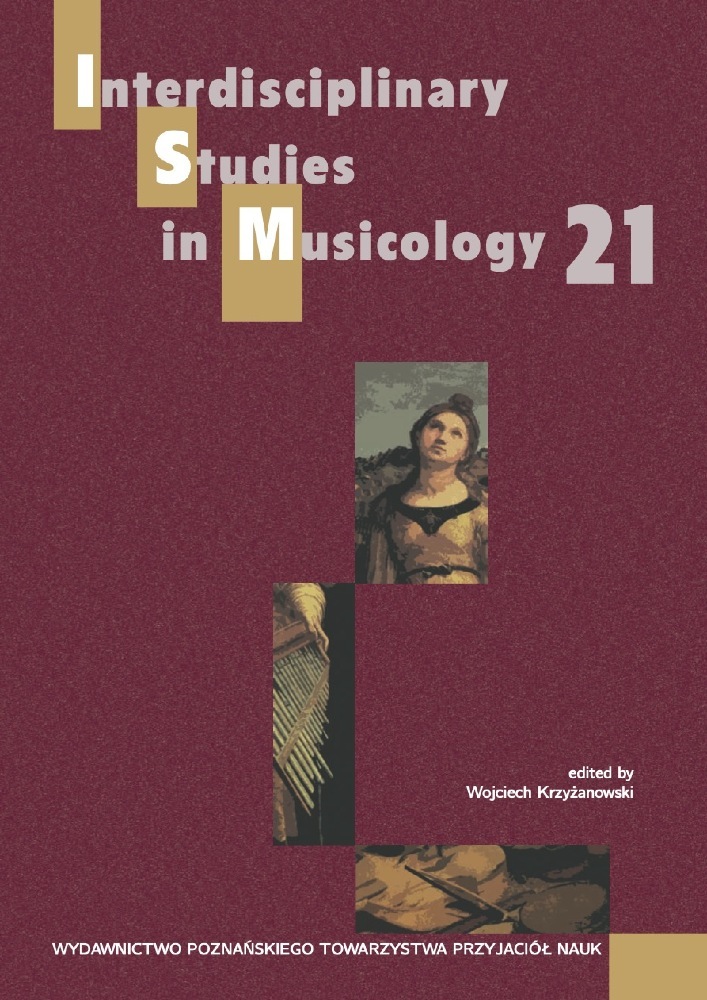Abstract
As the end of the album format is apparently drawing near due to the radical change in music consumption habits motivated by streaming services, artists and genres interested in creating musical works with meanings broader than those of single songs find themselves in a situation worth analysing. Despite all appearances and expectations, I argue that nowadays artists willing to create narrative, thematic or generally conceptual contexts for their songs are living in a potential second golden age of concept albums. Some attempts at keeping the (concept) album alive are more alike to an act of resistance, others creatively take advantage of the same means of communication used by their digital enemy, in order to create something unique and capable of taking the place of the supposedly doomed CD/lP format. They are often transmedial works, thus requiring an interdisciplinary analysis. In this paper, I offer an overview of the contemporary situation of the album format (and concept album more specifically) and finally propose a classification of four forms of contemporary musical world-building strategies, starting from a selection of emblematic case studies.
References
Borders, J. (2001). Form and the Concept Album: Aspects of Modernism in Frank Zappa’s Early Releases. Perspectives of New Music, 39(1), 118–160.
Burns, l. (2016). The Concept Album as visual—Sonic—Textual Spectacle: The Transmedial Story- world of Coldplay’s MyloXyloto. IASPM@Journal, 6(2), 91–116.
Burns, l. (2018). Transmedia Storytelling in Steven Wilson’s The Raven That Refused to Sing. In C. Scotto, K. M. Smith & J. Brackett (Eds.), The Routledge Companion to Popular Music Analysis: Expanding Approaches (pp. 95–113), New York: Routledge Press.
Burns, l., & Mclaren, l. (2020). Interpreting the Materials of a Transmedia Storyworld: Word-Music-Image in Steven Wilson’s Hand. Cannot. Erase. (2015). In S. Zagorski-Thomas & A. Bourbon (Eds.), The Bloomsbury Handbook of Music Production (pp. 393–404). New York-London: Bloomsbury Publishing Inc.
Corbella, M. (2015). Performativity Through(out) Media: Analyzing Popular Music Performance in the Age of Intermediality. In C. Maeder & M. Reybrouck (Eds.), Music Analysis Experience: New Perspectives in Musical Semiotics (pp. 43–58). Leuven: Leuven University Press.
Decker, T. (2013). Fancy Meeting You here: Pioneers of the Concept Album. Daedalus, 142(4), 98–108.
Dibben, N. (2013). visualizing the App Album with björk’s biophilia. In C. vernallis, A. Herzog, & J. Richardson (Eds.), The Oxford Handbook of Sound and Image in Digital Media (pp. 682– 704). Oxford: Oxford University Press.
Emerick, G. (2007). Here, There and Everywhere. New York: Gotham Books.
Follero, D. (2009). Concept Album: I dischi a tema da Sgt. Pepper’s al nuovo millennio. Bologna: Odoya.
Ghost. (2018, March 31). Ghost – Chapter 1: New Blood [video]. YouTube. https://youtu.be/JKZ1yrenbIQ.
Hagen, A. N. (2015). The Playlist Experience: Personal Playlists in Music Streaming Services. Popular Music and Society, 38(5), 625–645.
Hiller, R. S., & Walter, J. (2015). No longer Durable? The Rise of Streaming Music and Implications for the bundled Album. SSRN Electronic Journal.
Hoad, C. (2018). “he Can be Whatever You Want him to be”: Identity and Intimacy in the Masked MATTIA MERlINI Performance of ghost. Popular Music, 37(2), 175–192.
Jagodic, M. D. (1975). Instructions for the listener. In Tempo Furioso [liner Notes, 2021 Reissue]. Cramps.
Johansson, S. (2019). Music in Times of Streaming: Transformation and Debate. In M. Deuze & M. Prenger (Eds.), Making Media: Production, Practices, and Professions (pp. 309–320). Amsterdam: Amsterdam University Press.
Kscope. (2015, February 11). Steven Wilson – Perfect Life (from Hand. Cannot. Erase.) [video]. YouTube. https://youtu.be/PyelZ_KeUik.
Kscope. (2016, October 28). Steven Wilson – Happy Returns (from Hand. Cannot. Erase.) [video]. YouTube. https://youtu.be/l7uls7grg5Y.
Lacasse, S. (2000). Intertextuality and hypertextuality in Recorded Popular Music. In M. Talbot (Ed.), The Musical Work: Reality or Invention? (pp. 35–58). Liverpool: Liverpool University Press.
Letts, M. T. (2010). Radiohead and the Resistant Concept Album: How to Disappear Completely. Bloomington: Indiana University Press.
Lynskey, D. (2015). Why Everyone from beyoncé to Daft Punk is Releasing a Concept Album. GQ Magazine.GQ Magazine. https://www.gq-magazine.co.uk/article/concept-album-muse-kendrick-lamar-beyonce-daft-punk.
Macan, E. (1997). Rocking the Classics: English Progressive Rock and the Counterculture. Oxford: Oxford University Press.
Martin, b. (1998). Listening to the Future: The Time of Progressive Rock, 1968–1978. Chicago: Open Court.
Mench, C. (2019). Here’s Everything We Know About billie Eilish’s Debut Album “When We All Fall Asleep, Where Do We go?” Genius. https://genius.com/a/everything-we-know-about-billie-eil-ish-s-debut-album-when-we-all-fall-asleep-where-do-we-go-tracklist-cover-art-release-date-producers.
Merlini, M. (2022). A Mellotron-Shaped Grave: Deconstructing the Death of Progressive Rock. Transposition: Musique et sciences sociales, 10.
Miereanu, C. (1975). Subsequent listening / Simultaneous listening / Oblique listening. In Luna Cinese [liner Notes, 2021 Reissue]. Cramps.
Olivier, b. (2018). What’s in Store for the Album Format as Streaming Keeps breaking All the Rules? Experts Weigh In. Billboard. https://www.billboard.com/articles/events/year-in-music-2018/8491284/album-format-changing-streaming-2018.
Powers, A. (2019). The Album is Evolving. Slate.https://slate.com/culture/2019/12/music-club-2019-concept-albums-not-dead.html.
Ryan, M.-l. (2014). Story/Worlds/Media: Tuning the Instruments of a Media-Conscious Narratology. In M.-l. Ryan & J.-N. Thon (Eds.), Storyworlds Across Media: Toward a Media-Conscious Narratology (pp. 25–49). Lincoln-London: University of Nebraska Press.
Sa Dias, F. (2014). Album Apps: A New Musical Album Format and the Influence of Open Works. Leonardo Music Journal, 24(24), 25–27.
Shute, g. (2013). Concept Albums. USA: Investigations Publishing.
Simon, P. (2015). Hand. Cannot. Erase. — An Interview with Steven Wilson. HuffPost. https://www.huffpost.com/entry/hand-cannot-erase-an-inte_b_6778506.
Tagg, P. (2012). Music’s Meanings: A Modern Musicology for Non-Musos. New York-Huddersfield: MMMSP.
Thon, J.-N. (2016). Transmedial Narratology and Contemporary Media Culture. Lincoln-London: University of Nebraska Press.
Tunbridge, l. (2010). The Song Cycle. Cambridge: Cambridge University Press.
u/[deleted]. (2020, February 08). The Protagonist in hand. Cannot. Erase. Does Not Die [Online forum post]. Reddit. https://www.reddit.com/r/stevenwilson/comments/f0thou/the_protagonist_in_hand_cannot_erase_does_not_die/.
u/hatton93. (2020, February 02). hand. Cannot. Erase Concept Mystery? [Online forum post]. Reddit. https://www.reddit.com/r/stevenwilson/comments/expfcg/handcannoterase_concept_mystery/.
Wener, B. (2006). Concept Albums Are Once Again in vogue in the Digital Age. Pop Matters. http://www.popmatters.com/pm/feature/concept-albums-areonce-again-in-vogue-in-the-digital-age/ .
Wikström, P. (2019). The Music Industry: Music in the Cloud (3rdEd.). Medford: Polity.
Wilson, S. (2015a). Hand. Cannot. Erase. Official Website. https://web.archive.org/web/20160410132301/http://handcannoterase.com:80/.
Wilson, S. (2015b, October 29). Steven Wilson – Routine [video]. YouTube.https://youtu.be/sh5mWzKlhQY.
Wilson, S. (2016, May 16). Steven Wilson – Hand Cannot Erase[video]. YouTube. https://youtu.be/A64J8mo8oZE .

